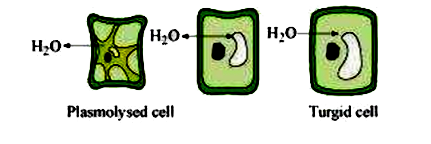(a) With the help of well-labelled diagrams, describe the process of plasmolysis in plants, giving appropriate examples.
(b) Explain what will happen to a plant cell if it is kept in a solution having higher water potential.
(a) Plasmolysis can be defined as the shrinkage of the cytoplasm of a plant cell, away from its cell wall and toward the centre. It occurs because of the movement of water
from the intracellular space to the outer-cellular space. This happens when the plant cell is placed in a hypertonic solution (i.e., a solution having more solute concentration than the cell cytoplasm). This causes the water to move out of the cell and toward the solution. The cytoplasm of the cell shrinks and the cell is said to be plasmolysed. This process can be observed in an onion peel kept in a highly concentrated salt solution.

(b) When a plant cell is placed in a hypertonic solution or a solution having higher water potential, the water diffuses into the cell (i.e., movement is observed from higher to lower water pressure region). The entry of water in the plant cell exerts pressure on the rigid cell wall. This is called turgor pressure. As a result of its rigid cell wall, the plant cell does not burst.
Topper's Solved these Questions
Similar Questions
What will happen to a plant cell if it is kept in a solutin having higher water potential ?
View SolutionIf a plant cell is kept in solution having higher water potential, what will happen ?
View SolutionWith the help of well labelled diagrams describe the structure of a typically bacterial cell.
View SolutionExplain what would happen if:
A plant is kept near an open window
View SolutionA cell is kept in water having low water potential. What will happen?
View SolutionWith the help of suitable diagrams, describe :
(a) Binary fission in plants (b) Budding in Yeast cell
View SolutionWith the help of a labelled diagram,describe how electricity is gnerated in a nuclear power plant?
View SolutionExplain the structure of RNA with the help of a well labelled diagram. Describe its role in the process of translation.
View SolutionDraw a well labelled diagram to show the anaphase stage of mitosis in a plant cell having four chromosomes.
View SolutionWhat will happen if a plant cell and animal cell are placed in a hypertonic solution?
View Solution
